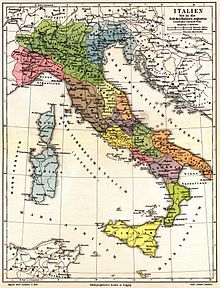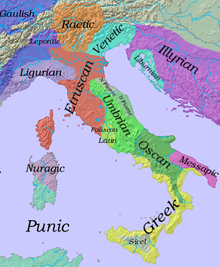
The Celtic languages are a group of related languages descended from Proto-Celtic. They form a branch of the Indo-European language family. The term "Celtic" was first used to describe this language group by Edward Lhuyd in 1707, following Paul-Yves Pezron, who made the explicit link between the Celts described by classical writers and the Welsh and Breton languages.

Cisalpine Gaul was the name given, especially during the 4th and 3rd centuries BC, to a region of land inhabited by Celts (Gauls), corresponding to what is now most of northern Italy.

The Ligures or Ligurians were an ancient people after whom Liguria, a region of present-day north-western Italy, is named.

The Bituriges Cubi were a Gallic tribe dwelling in a territory corresponding to the later province of Berry, which is named after them, during the Iron Age and the Roman period. They had a homonym tribe, the Bituriges Vivisci, in the Bordelais region, which could indicate a common origin, although there is no direct evidence of this.

Lepontic is an ancient Alpine Celtic language that was spoken in parts of Rhaetia and Cisalpine Gaul between 550 and 100 BC. Lepontic is attested in inscriptions found in an area centered on Lugano, Switzerland, and including the Lake Como and Lake Maggiore areas of Italy. Being a Celtic language, its name could derive from Proto-Celtic *leikwontio-.
The Volcae were a Gallic tribal confederation constituted before the raid of combined Gauls that invaded Macedonia c. 270 BC and fought the assembled Greeks at the Battle of Thermopylae in 279 BC. Tribes known by the name Volcae were found simultaneously in southern Gaul, Moravia, the Ebro valley of the Iberian Peninsula, and Galatia in Anatolia. The Volcae appear to have been part of the late La Tène material culture, and a Celtic identity has been attributed to the Volcae, based on mentions in Greek and Latin sources as well as onomastic evidence. Driven by highly mobile groups operating outside the tribal system and comprising diverse elements, the Volcae were one of the new ethnic entities formed during the Celtic military expansion at the beginning of the 3rd century BC. Collecting in the famous excursion into the Balkans, ostensibly, from the Greek point of view, to raid Delphi, a branch of the Volcae split from the main group on the way into the Balkans and joined two other tribes, the Tolistobogii and the Trocmi, to settle in central Anatolia and establish a new identity as the Galatians.

The Cynetes or Conii were one of the pre-Roman peoples of the Iberian Peninsula, living in today's Algarve and Lower Alentejo regions of southern Portugal, and the southern part of Badajoz and the northwestern portions of Córdoba and Ciudad Real provinces in Spain before the 6th century BCE. According to Justin's epitome, the mythical Gargoris and Habis were their founding kings.
The Reii were a Celto-Ligurian tribe dwelling in the modern department of Alpes-de-Haute-Provence during the Iron Age and the Roman period.
The Salyes or Salluvii were an ancient Celto-Ligurian people dwelling between the Durance river and the Greek colony of Massalia during the Iron Age. Although earlier writers called them 'Ligurian', Strabo used the denomination 'Celto-ligurian' in the early 1st century AD. A Celtic influence is noticeable in their religion, which centred on the cult of the tête coupée, as well as in the names of their towns and leaders. During the 2nd century BC, the Salyes were most likely at the head of a political and military confederation that united both Gallic and Ligurian tribes.
Ancient Belgian is a hypothetical extinct Indo-European language, spoken in Belgica in late prehistory. It is often identified with the hypothetical Nordwestblock. While it remains a matter of controversy, the linguist Maurits Gysseling, who attributed the term to SJ De Laet, hypothesised a Belgian that was distinct from the later Celtic and Germanic languages. According to the theory, which was further elaborated by Hans Kuhn and others, traces of Belgian can be found in certain toponyms such as South-East-Flemish Bevere, Eine, Mater and Melden.
Bellovesus is a legendary Gallic chief of the Bituriges, said to have lived ca. 600 BC. According to a legend recounted by Livy, the king Ambigatus sent his sister's sons Bellovesus and Segovesus in search of new lands to settle because of overpopulation in their homeland. While Segovesus headed towards the Hercynian Forest, Bellovesus is said to have led the Gallic invasion of the Po Valley during the legendary reign of the fifth king of Rome, Tarquinius Priscus, where he allegedly conquered the Etruscans and founded the city of Mediolanum (Milan).

The prehistory of Corsica is analogous to the prehistories of the other islands in the Mediterranean Sea, such as Sicily, Sardinia, Malta and Cyprus, which could only be accessed by boat and featured cultures that were to some degree insular; that is, modified from the traditional Paleolithic, Mesolithic, Neolithic and Chalcolithic of European prehistoric cultures. The islands of the Aegean Sea and Crete early developed Bronze Age civilizations and are accordingly usually treated under those categories. Stone Age Crete however shares some of the features of the prehistoric Mediterranean islands.

The Bituriges Vivisci were a Gallic tribe dwelling near modern-day Bordeaux during the Roman period. They had a homonym tribe, the Bituriges Cubi in the Berry region, which could indicate a common origin, although there is no direct of evidence of this.
The Caturiges were a Gallic tribe dwelling in the upper Durance valley, around present-day towns of Chorges and Embrun, during the Iron Age and the Roman period.
The Avantici were a small Gallic tribe dwelling around present-day Gap, in the western part of the modern Hautes-Alpes department, during the Roman period.
The Vediantii were a Celto-Ligurian tribe dwelling on the Mediterranean coast, near present-day Nice, during the Iron Age and the Roman period.











